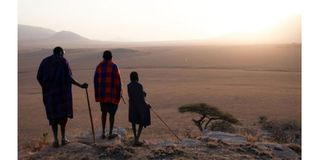Land conflicts top challenges facing nomadic herders: study

What you need to know:
- Other challenges are scarcity of water for domestic uses and for livestock the just-concluded survey, which covered 386 pastoralist villages in 89 districts in 14 regions says
Arusha. Land conflicts top the list of challenges facing nomadic herders in the country, according to a countrywide survey.
Land disputes are followed by scarcity of water for domestic uses and for livestock due to recurrent droughts. The just-concluded survey covered 386 villages in 89 districts in 14 regions inhabited by the traditional pastoralists.
Dr Elias Nagol, the research team leader, said land disputes are ahead of the five ‘most burning’ challenges facing the communities.
He revealed this during a recent validation workshop held in Dar es Salaam on environmental and social impacts of projects funded by the government or development partners.
The survey covered the Maasai and Barbaig nomadic communities and their sub tribes now scattered in many regions across the country.
Originally, the two communities inhabited the grazing plains of Arusha and Manyara and to a lesser extent in Simiyu and Singida regions.
From the 1980s, they have been forced by the shrinking land and recurrent droughts to move to the southern, central and coastal regions. Land conflicts touching the traditional herders have been exacerbated by the struggle for water among multiple users.
The nomadic communities, according to Dr Nagol, had also been excluded from the state-sponsored economic empowerment programmes.
He cited the Tanzania Social Action Fund (Tasaf) financial support to the poor and vulnerable families and communities.
“Many of the cattle herders complain that they remain excluded from receiving Tasaf funds,” he told representatives of the livestock keepers and hunter-gatherer groups at the World Bank premises in Dar es Salaam. Although the livestock communities shunned education in the past, they are now complaining that they were hardly getting slots for their kids in schools. Turning to the hunter-gatherers, the research team leader said their main challenges were largely scarcity of food.
Food insecurity to the minority groups, it emerged, is closely linked to prevailing environmental conditions, often hit by droughts.
“These include disappearing bees and invasion of their land by other land users like cattle keepers and farmers,” he explained.
The famous hunter-gatherer tribe in Tanzania are the Hadzabe living in the Lake Eyasi basin at the borders of Arusha, Manyara, Singida and Simiyu regions.
Others include Akie found in different areas in Simanjiro and Kiteto districts in Manyara region and in Kilindi district in Tanga region.
The two groups, and others not identified or described, are believed to be the last remnants of Stone Age culture in Tanzania.
Their survival, specifically food source, is wholly tied to the well being of nature; honey being one of their staples besides wild fruits and roots.
Dr Nagol, a spatial science expert, said the survival of both the hunter-gatherers and traditional herders in Tanzania were in danger. “For the hunter-gathers their vulnerability is not their attachment to the land but natural resources”, he said, adding;
“For the herders it is the shrinking grazing land,” he said citing the Barbaigs who lost thousands of hectares to a former Canadian-supported wheat project.
Nicholas Meitiaki Ole Soikan, a World Bank senior social development specialist, said the disadvantaged groups should not be discriminated against for their status.
He told the meeting that the Bretton Woods institution would not approve projects which discriminated against their cultural livelihoods.




